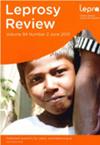Clinical profile of patients with pure neuritic leprosy: 20 years’ experience at a tertiary referral centre from North India
IF 0.8
4区 医学
Q4 DERMATOLOGY
引用次数: 0
Abstract
Introduction Pure neuritic leprosy (PNL) is characterized by enlargement of peripheral nerves, sensory loss without any cutaneous lesions, skin slit smear negativity and a variable lepromin test and histopathology. Methods This was a retrospective analysis of the clinical records of all the leprosy patients enrolled in the Leprosy Clinic, during the years 1999–2019. The patient records fulfilling the diagnostic criteria of PNL were considered for analysis. Results A total of 1225 patients registered leprosy cases, out of which 41 (3.3%) patients were diagnosed with PNL. Mean age was 31 years and 80% patients were male. Multiple nerves were affected in 25 (61%) patients and one nerve was found to be affected in only 16 (39%) patients. Grade 2 deformities were seen in 26 (63%) patients. All patients were treated with multi-drug therapy 25 patients received the multibacillary regimen and 16 received the paucibacillary regimen; 27 (66%) patients completed the treatment as prescribed. Conclusion Leprosy is the most common treatable cause of peripheral neuropathy. Therefore, early detection of leprosy neuropathy is important for preventing deformities and disabilities. It may be advisable to treat all PNL cases with the multibacillary multidrug therapy in view of higher rate of deformities.纯神经性麻风病患者的临床概况:印度北部三级转诊中心20年的经验
纯神经性麻风病(PNL)的特点是周围神经扩大,感觉丧失,无任何皮肤病变,皮肤裂隙涂片阴性,麻黄素试验和组织病理学变化。方法回顾性分析1999-2019年在麻风门诊登记的所有麻风患者的临床记录。对符合PNL诊断标准的患者记录进行分析。结果1225例麻风病例,其中41例(3.3%)为PNL。平均年龄31岁,80%为男性。25例(61%)患者有多根神经受累,仅16例(39%)患者有一根神经受累。26例(63%)患者出现2级畸形。所有患者均采用多药联合治疗,多菌联合治疗25例,少菌联合治疗16例;27例(66%)患者完成了处方治疗。结论麻风病是周围神经病变最常见的可治疗的病因。因此,早期发现麻风神经病变对于预防畸形和残疾是重要的。鉴于畸形发生率较高,所有PNL病例均宜采用多菌联合多药治疗。
本文章由计算机程序翻译,如有差异,请以英文原文为准。
求助全文
约1分钟内获得全文
求助全文
来源期刊

Leprosy review
医学-病理学
CiteScore
1.10
自引率
16.70%
发文量
35
审稿时长
>12 weeks
期刊介绍:
Leprosy Review is an Open Access peer reviewed journal including original papers on all aspects of leprosy. Topics published include research into the medical, physical and social aspects of leprosy and information relevant to leprosy control. We publish original research, short reports, case studies and reviews. The vision of the journal is to improve the management and control of leprosy and its consequences, by publishing relevant research and sharing experiences and best practices.
 求助内容:
求助内容: 应助结果提醒方式:
应助结果提醒方式:


